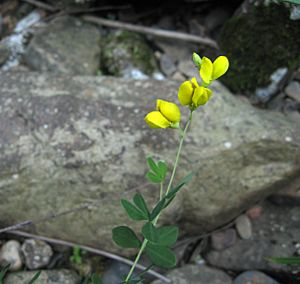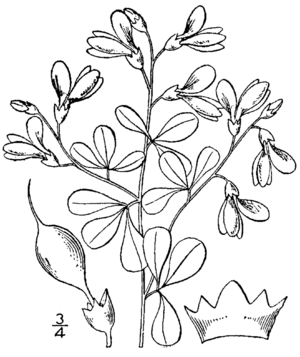Baptisia tinctoria facts for kids
Quick facts for kids Baptisia tinctoria |
|
|---|---|
 |
|
| Scientific classification | |
| Genus: |
Baptisia
|
| Species: |
tinctoria
|
The Baptisia tinctoria is a cool plant with several common names like yellow false indigo, wild indigo, and horseflyweed. It's a type of perennial plant, which means it lives for more than two years, and it belongs to the Fabaceae family, also known as the pea or bean family. This plant naturally grows in the eastern parts of North America.
Contents
Where Does Wild Indigo Grow?
You can find Baptisia tinctoria across the eastern United States. Its range stretches from Minnesota in the west all the way down to Florida in the south.
Protecting This Special Plant
Because it's rare in some areas, a few states are working to protect it. For example, in Kentucky, it's considered a threatened plant. In Maine, it's even more rare and is listed as endangered. This plant likes to grow in dry meadows and open forests.
What Does Wild Indigo Look Like?
The Baptisia tinctoria plant has many bushy stems that can grow quite tall, reaching about 2 to 3 feet high. Its leaves are a pretty silver-green color. Each leaf is divided into three smaller leaflets, which are about half an inch long.
Its Bright Yellow Flowers
The flowers of this plant are bright yellow. They grow in tall spikes that are usually between 1½ and 3 inches long. These flowers make the plant easy to spot in its natural habitat.
Who Eats This Plant?
Some caterpillars, which are the young forms of moths and butterflies, enjoy eating the leaves of the wild indigo. One example is the Io moth caterpillar (Automeris io).
A Plant That Tumbles!
On Martha's Vineyard, an island off the coast of Massachusetts, this plant acts like a tumbleweed. It grows into a round shape. In the autumn, it breaks off from its roots and rolls around in the wind!
See Also
 In Spanish: Añil basto para niños
In Spanish: Añil basto para niños


